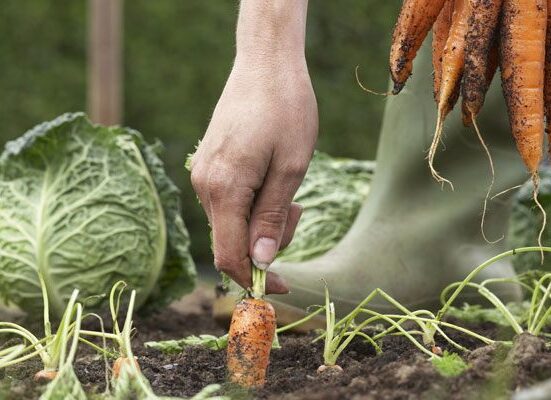Your vegetable garden isn’t just for growing your own organic fruits and veggies. An easy-to-maintain vegetable patch is also ideal for attracting a variety of wildlife. While you may not be able to attract a host of different birds and animals, you can certainly make the most of your space by planting ornamental plants that are friendly to bees, butterflies, and beneficial insects.
Not only will doing so help you enjoy the outdoors more, but it will also help you save money on groceries by growing your own fresh vegetables. Even if you don’t have a huge yard, an enclosed vegetable garden is enough space to grow a variety of greens that you can use throughout the year.
You can even take advantage of vertical spaces such as fences or walls in your backyard or front yard by planting climbing crops such as tomatoes, peas, beans, or even strawberries instead of hardy perennial plants that need a lot of space.
Plan Your Vegetable Garden Before You Build It
The best thing you can do before planting your vegetable garden is to create an accurate plan. You don’t need to invest a lot of time into planning out your garden, especially if you don’t have a large backyard. However, creating a plan gives you a better idea of how much space your garden will require, which will help you decide where to build it in your backyard.
The next thing you should do is research the different types of vegetables and herbs that grow best in your area. While you don’t have to only grow vegetables, you should choose vegetables that are easy to grow, with minimal pest and disease issues.
There are also different varieties of vegetables that are better suited for warmer or colder climates. You can further narrow down your options by looking at the local availability of vegetables and herbs that are suitable for your region.
Create A Healthy Soil Layer For Your Plants
Even though you want to grow healthy vegetables, the soil will be the medium in which your plants will grow. When you add compost and organic material to your soil, you can improve its quality. When you have healthy soil, you can grow healthy plants, which means you will have more vegetables in your garden.
When you don’t have a backyard and are planting a small garden, you can still create a healthy soil layer by using a compost bin. You can also add natural materials such as pebbles, sand, and soil conditioners to your compost bin. When you need to add more soil to the layer, you can add a layer of soil and then cover it with organic matter.
Add nitrogen-rich plants to your garden
If you want to grow healthy vegetables, you will need to add nitrogen-rich plants to your garden. These can include legumes, such as peas and beans, or you can grow them in your garden. You can also grow alfalfa in your garden, which is a nitrogen-rich plant that is often grown on farms for animals.
You can also grow vegetables such as potatoes, tomatoes, or cucumbers in your garden, which are nitrogen-rich plants. While adding nitrogen-rich plants to your garden is a great way to grow healthy vegetables, it will also attract a variety of wildlife to your backyard.
For example, alfalfa attracts pollinators, while potatoes are a source of protein for many wild animals. Making sure you have healthy soil, including added organic material, will help you grow healthy vegetables that are a great source of protein for wildlife.


Decide On Which Flowers To Plant And When
Wildlife-friendly gardens are often planted with flowering shrubs and perennials, which provide seasonal color and attract hummingbirds, butterflies, bees, and other beneficial insects. When designing your wildlife-friendly garden, you can use wildflowers from your own backyard, or you can plant flowers from a local flower farm. Before planting your vegetable garden, though, you should decide on the types of vegetables you want to grow.
You can further narrow down your options by looking at the local availability of vegetables and herbs that are suitable for your region. You can also use a local garden journal to keep track of what’s in season in your area. You can use this journal to keep track of what’s in season, what flowers and herbs are available, and to determine when to plant your garden.
6 Tips on How To Stay Fauna Comfortable In Your Backyard
- Create a food source for insects and birds by planting a bird feeder.
- Add a pond to your garden to provide water for birds and animals, and to create a natural habitat for frogs and fish.
- Plant a shade tree in your backyard to create a shady environment that is cooler than the sun, which is often too hot for birds and other wildlife.
- Install a bird feeder in your backyard to encourage the growth of birds and other wildlife.
- Install a wildlife-friendly garden faucet to provide a natural source of water in your backyard.
- Install a wildlife-friendly sprinkler in your backyard to create a comfortable habitat for wildlife.
Conclusion
The easiest way to make your backyard more wildlife friendly is by planting an ornamental garden, especially a herb or flower garden. You don’t need to be a gardener to create an attractive garden that is friendly to wildlife. This makes it easy to enjoy your backyard more, and it also means you don’t have to invest much time into creating the garden.
In addition to adding plants and trees to your backyard, you can create a backyard habitat in your front yard by installing bird feeders and birdhouses, or by installing a bird bath. These are easy-to-install backyard habitats that will help you enjoy your space as well as attract a variety of wildlife to your property.






Leave feedback about this